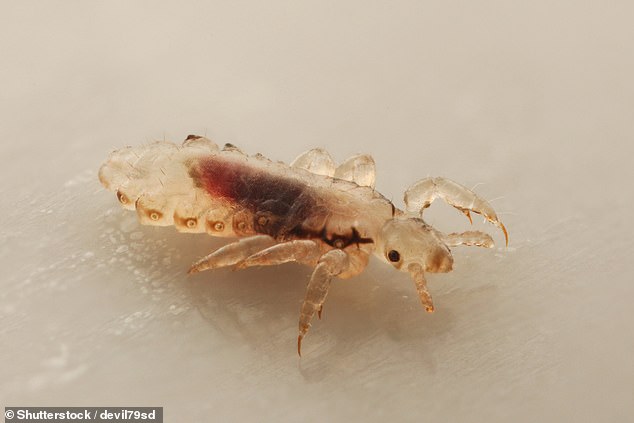ANOTHER outbreak? Head lice warning as Superdrug reports demand for anti-insect lotion increases by 121 percent
- READ MORE: The BIGGEST head lice myths everyone believes
Sales of head lice sprays have risen 121 percent this week, pointing to an outbreak of the insects in Britain.
Well-known chemist Superdrug believes the recent warmer weather has led to plagues across the country.
However, the NHS said visits to her Head lice advice page had remained stable at around 10,000 per week in April and May.
The common playground parasites are a perennial concern for parents who want to avoid the painful process of treating the family’s hair with strong-smelling chemicals and washing every bedding in the house.
Head lice are small insects that live in the hair and lay their eggs on the hair near the scalp.
Lice can also be contracted by sharing tools such as brushes, combs or towels with someone with an infestation

Adults can live on your scalp for up to 30 days
Head lice can affect anyone, but is more common in children aged four to twelve.
During the warmer summer months, head-to-head transmission is more likely because children play outside more often.
Superdrug Pharmacy Chief Inspector Niamh McMillan said: ‘We normally see a peak in our head lice products around the school term in September, so it is unusual to see such a strong increase in sales last week.
‘It has been a long winter in the UK and the recent warmer weather has seen many children taking advantage of the opportunity to play outside together, leading to an increased risk of head lice transmission from head to head.
‘Although head lice can thrive in all temperatures, more pleasant weather can cause head lice infestation, and that is what we are seeing.
‘If you suspect your child has head lice, the first step is to inspect the head. Only start treating head lice once you have noticed lice in your hair. We recommend that you check your child’s head regularly.’
There are two main options for treating head lice infestations.
The most effective method is wet combing: Gently pull a fine-tooth comb through sections of wet hair, from roots to ends, wiping the comb after each pass as you check for lice.
Alternatively, chemical head lice treatments can help kill head lice and eggs in the hair. They are usually applied liberally to the hair and left on for two minutes before washing out.
Last year, a TikTok account revealed that as many as 20,000 of the tiny insects can live on your head after a month if left untreated.
NHS England noticed a rise in visits to its head lice advice page last September, indicating there had been an outbreak.
Dame Ruth May, Chief Nursing Officer for England, said at the time: ‘Head lice and nits are a common problem, especially among young children and families who are in close contact with each other.
‘Once discovered, there is no need to consult a GP but treatment should begin immediately and all household members should be monitored and treated to stop further spread.
‘The NHS head lice and nits advice page provides the latest advice on how to manage the condition and control any outbreaks of head lice and nits.’
The NHS recommends washing hair with shampoo, smothering with conditioner, then ccomb the entire head from root to tip with a fine-toothed comb, available from chemists or online.
The process should be repeated every four days for two weeks to catch any newly hatched head lice.
